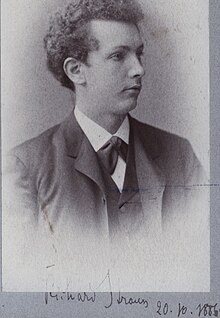Burlesque (Strauss)
The burlesque in D minor for piano and orchestra by Richard Strauss (1864–1949), composed in 1885/86, was premiered in 1890 with the soloist Eugen d'Albert in Eisenach .
Origin and premiere
In 1885, on Hans von Bülow's initiative, the 21-year-old Richard Strauss came to Meiningen as Kapellmeister in order to act as assistant and representative of Bülows at the court orchestra there . The burlesque in D minor for piano and orchestra, which Strauss had intended for his mentor, was written here in 1885/86 . Von Bülow - although an excellent pianist who, for example , had taken over the world premiere of Tchaikovsky's 1st Piano Concerto in 1875 - refused to practice the work and explained: “Every bar a different hand position - believe me, I sit down for four weeks, that's how it is to study a hairy piece? ”The frustrated composer then abandoned burlesque for years. A rhapsody in C sharp minor for piano and orchestra, also begun in Meiningen, remained a sketch.
It was not until 1890 that Eugen d'Albert took on the burlesque and premiered it in a form revised by Strauss on June 21, 1890 at the Eisenacher Tonkünstlerfest of the Allgemeine Deutsche Musikverein . The symphonic poem Death and Transfiguration was also premiered at this concert, which the composer conducted himself .
Cast and playing time
In addition to the solo piano, the score provides for the following scoring : flute piccolo , 2 flutes , 2 oboes , 2 clarinets , 2 bassoons , 4 horns , 2 trumpets , 4 timpani and strings .
The performance lasts about 20 minutes.
Characterization and reception
The designated first as "Scherzo" work (in a letter to his mother said Strauss, by a "Piano Concerto") was not the first concert composition by Richard Strauss, was preceded - in addition yet previous attempts - the Violin Concerto op. 8 and the 1 Horn Concerto op.11 .
The burlesque , entitled Allegro vivace, is in one movement and is laid out in the sonata form with a ritornello solo change that is usual for concert movements . In its motif structure and also harmonious progressions, it shows influences from Johannes Brahms , whom Strauss had met personally in Meiningen in 1885. On the other hand, in its exuberance and waltz character of the main theme, it shows characteristics typical of Strauss. The solo timpani are unusual, the four-tone head theme of which characterizes the work through repeated recurrences. The timpani also receives the “last word” in the original diminuendo finish.
Von Bülow described the burlesque after the performance by d'Albert as “brilliant”, but also “terrifying”. Strauss, at the time of the premiere in 1890, was now following Franz Liszt and Richard Wagner in terms of composition , justified himself to Alexander Ritter , a supporter of the New German School , that it was a work “that I am far beyond and for which I no longer fully Conviction can stand up ”, the burlesque later saw as the result of his“ Brahms rapture at the time ”and is said to have conducted it“ always extremely lovelessly ”.
Richard Strauss decided not to assign an opus number to the burlesque that was published in 1894 by Verlag Steingräber (Leipzig) and dedicated to d'Albert . In the catalog raisonné of Franz Trenner (TrV) it received the number 145.
Strauss was only to return to the piano (especially for the left hand) and orchestra about 30 years later: with a Parergon to the Symphonia domestica op.73 and the Panathenäenzug op.74 , each composed for the one-armed Paul Wittgenstein .
For a long time hardly represented in the concert business, the burlesque did not gain greater attention until the end of the 20th century, not least through Glenn Gould . The soloists who have recently recorded or performed the work include Martha Argerich , Emanuel Ax , Hélène Grimaud , Friedrich Gulda , Gerhard Oppitz , Sviatoslav Richter , Rudolf Serkin and Rudolf Buchbinder .
Individual evidence
- ↑ cit. n. Ernst Krause: Richard Strauss. Piper, Munich 1988, ISBN 3-492-10851-2 , p. 40
- ↑ cit. n. Walter Werbeck (Ed.): Richard Strauss Handbook . Metzler / Bärenreiter, Stuttgart 2014, ISBN 978-3-476-02344-5 , p. 450
- ↑ cit. n. Walter Werbeck (Ed.): Richard Strauss Handbook . Metzler / Bärenreiter, Stuttgart 2014, ISBN 978-3-476-02344-5 , p. 451
literature
- Wulf Konold (Ed.): Lexicon Orchestermusik Romantik. SZ . Piper / Schott, Mainz 1989. ISBN 3-7957-8228-7 , p. 927
- Walter Werbeck (Ed.): Richard Strauss Handbook . Metzler / Bärenreiter, Stuttgart 2014, ISBN 978-3-476-02344-5 , pp. 449–451
Web links
- Strauss: Burlesque : sheet music and audio files in the International Music Score Library Project
- Factory introduction by Verena Großkreutz
- Factory introduction BR-Klassik, June 17, 2014 ( Memento from July 28, 2014 in the Internet Archive )
